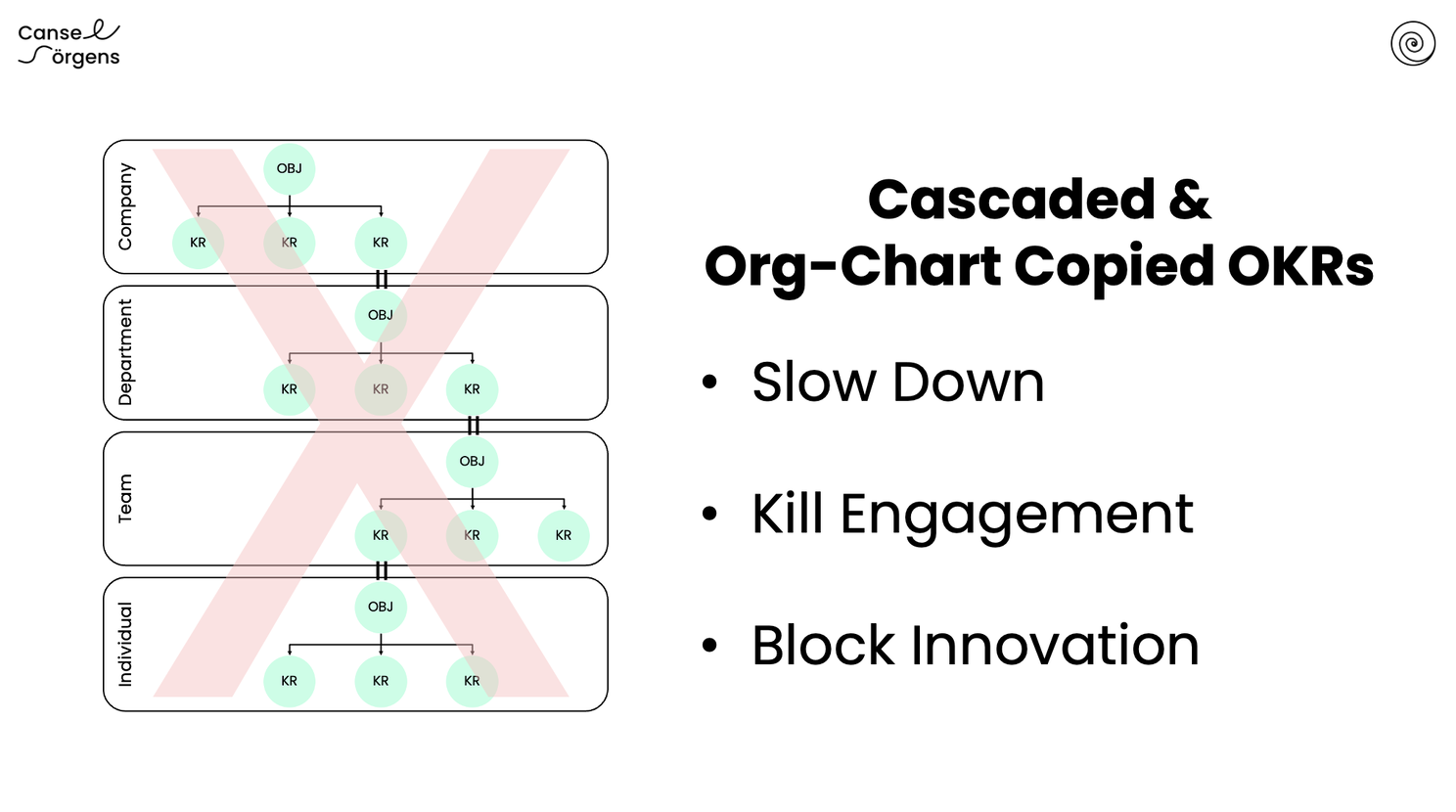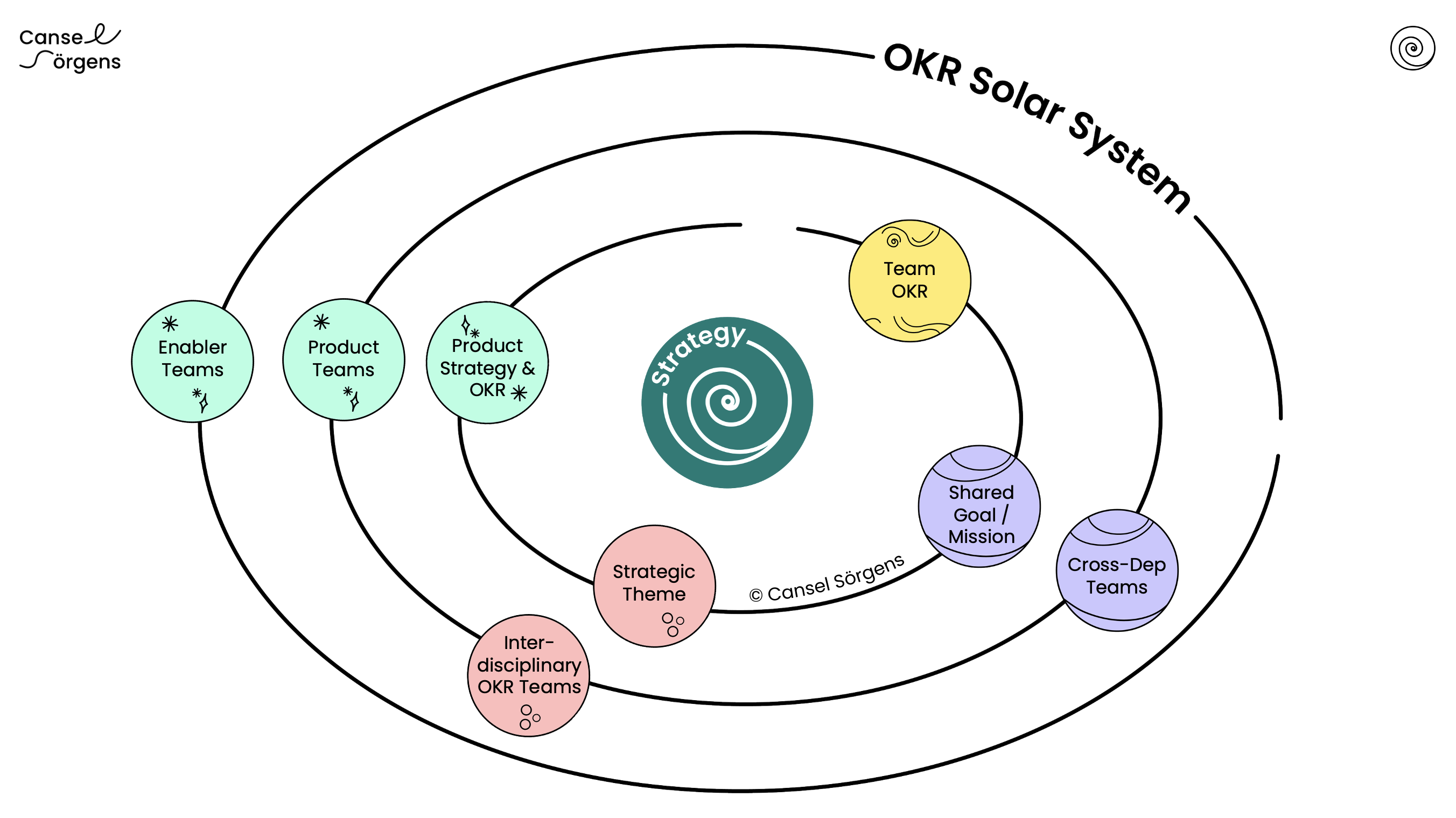- “Our people think OKR is overhead and meaningless. Can you help us to change it?” asks me a client.
- “What was the problem you wanted to solve with OKR?” I ask back.
- “We want alignment with vision and strategy.” they say.
In fact, 90% of the organisations name “alignment with vision and strategy.” as reason for implementing OKR.

3 most common ways what companies do to create alignment
1. Cascading OKR & Inherited OKR

The most common way I see is cascading OKR, either based on levels or even worse inheriting OKR from upper levels, where the Key Results of the upper level becomes the Objective of the next level and so on. Although for decades it has been understood that OKR must cascade from top to bottom in order to establish alignment, time and again this approach proves to be impractical.
A cascading OKR architecture has the following disadvantages:
- In a cascading OKR architecture, where the lower organisational level has to take over the OKR from the level above, the employees are left with no room for own ideas. This type of cascading OKR architecture limits any creativity and autonomy.
- Teams have to wait until all higher levels have defined their OKR sets and a change of an OKR set in one place triggers a chain reaction, that all related OKR sets have to be adjusted as well. This slows down the whole OKR process.
- The larger the organisation, the higher the effort until all have defined their OKR Sets and aligned with other teams. This causes a lot of time spent in sync meetings, which is certainly not in the spirit of OKR implementation.
2. Copy Org-Chart & Interdependent OKR Teams

Moreover, I see OKR models that copy the org charts, automatically creating interdependent OKR teams, because to be honest, the org charts are rarely reflecting the way we actually collaborate. If teams can’t implement their OKR sets without input or support from other teams, this not only increases the coordination effort, but also the frustration of the team members, as they spend more time coordinating than realising their OKR sets, and the promised effect of effective work is not given.
Org-Chart Copied OKR / Interdependent OKR:
- Copy Dependencies
- Increase time spent in sync meetings
- Increase administration effort
3. OKR Silos

Another model I see is creating OKR silos. Every unit works on their own OKR, all working in different directions. This often causes priority conflicts, fights over shared resources and worst of it all, it moves the company nowhere.
We do all this to create alignment! However, what we get is:
- Frustrated and demotivated employees because there is no room for own ideas!
- Increased overhead, endless hours in meetings to sync OKRs.
- Priority conflicts because everyone wants to push their own OKRs.
The result is: Everyone hates OKR 😡

What does alignment mean actually?
Well, it’s not about knowing what others do, or telling what others should do, or making dependencies visible.
Alignment is having transparency of strategic focus and channelling efforts in one direction and creating cross-division and cross-level collaboration.

- „You want to create alignment between vision and strategy, right? Can you name your strategic priority?“ I ask them.
- „🤯“ is the reaction.
Everyone names something else. Or they name the same thing but mean different things.

A survey shows that only 22% of Senior Executives can name the strategic priorities of their companies. The lower the organisational level the worst it gets.
If people don’t know the strategy, how can we expect them to define meaningful OKRs? In fact, over 50% of companies who implemented OKR say, if they were to roll OKR out again, their priority would be “clarity of vision and strategy”.

But how can we create that clarity of vision and strategy?
- „To align short-term OKRs you first need a focused strategic direction.“ I recommend my clients.
- “🧐” client seems interested.
Strategic Focus
I recommend to create strategic focus and direction for the next 1-2 years.
While the long-term vision is an indispensable information, it is usually quite abstract, so there is a lot of vast space open for interpretation that results in teams working in different directions. To ensure that all forces are channelled in the same direction, or that the short-term OKR sets (3-4 months) from different teams move in the same direction, a directional strategic focus for a foreseeable future (12-18-24 months) is needed so that strategic alignment and focus can be established.

The strategy creates focus, makes the vision tangible, and provides a clear strategic direction for the next 12-18 months, by answering the questions “Where to play” and “How to win” from Roger L. Martin’s “Playing to Win” framework.
It provides direction and generates focus without saying exactly what needs to be done and at the same time excludes what does not need to be done. This strategic clarity helps the people involved to make autonomous decisions later in the OKR process and thus reduces the need for micro-management.
Build a solar system around the strategy
The strategic focus works as a magnetic power for everything else to align around and is a crucial element of a powerful OKR structure. With OKR structure I mean the organisational levels and team structures where OKR is applied.
Through the long-term vision and strategic choices, the OKR structure can be built like a ‘solar system‘, enabling dynamic collaboration in networks. Strategy represents the sun while OKR teams are the planets. Due to sun’s gravitational pull, the planets remain bound to it; nevertheless, each planet also revolves around itself and has its own rhythm. In addition, some planets also have their own satellites orbiting them.

OKR structure around the strategy
You need nothing else than a team. The form of the team can vary depending on what is needed. There are different types of OKR Team.
Functional Team OKR
You might have OKR teams based on a function such as Marketing, that can work completely independently on their own OKR, such as “establishing new marketing channels”.
Product OKR
In a product-oriented organisation, it makes sense to first define the product vision and strategy, and then the product teams can set their OKRs for the next 3-4 months. Sub-Product Teams and/or enabler teams can then align their work around the Product Strategy and OKR, by either deriving their day-to-day work from it or by defining their own OKRs that contribute to Product OKR.
Shared (Goal / Mission) OKR
Areas such as marketing can work independently on their own OKR sets (e.g., establish new marketing partnerships), but the strategy for launching a new product must be developed and implemented in collaboration with the product team. In such cases, it is recommended that the divisions jointly define so-called Shared (Goal and Mission) OKR, (first introduced by Felipe Castro). Then each team derives its respective action plan accordingly. When I was working with a product team, they told me they needed marketing team to move forward. I suggested marketing team representative to joins us in the next OKR definition workshop to align and sync their strategies. They ended up sharing an OKR set, while Marketing owned 1 Key Result, Product Team owned the other 2 Key Results. They broke out of their silos and met regularly to discuss and sync their tactics.
And finally, I’d like to share a different approach I’ve been experimenting with in the last couple of years.
Strategic Theme OKR
In every organisation there are always topics for which there are no dedicated teams (yet). Strategic themes such as developing new business models, new markets, transformation, etc. are typical examples, where the engagement of people from different functions, units, divisions are required to deliver a value.
Since none of the existing OKR models covered these kinds of needs of my clients, I started to experiment with a different model, that I call today “Strategic Theme OKR”.
For strategic themes, that are important but don’t have dedicated teams, we create dynamic interdisciplinary teams with volunteers, who are interested working in this specific topic and have the respective competencies. Depending on the development stage of the topic, different skills might be required. While the theme remains constant the team members change over the time. After each OKR cycle, everyone has the chance to re-asses their involvement, if, why, and how they want to continue to contribute, hence dynamic teams.
I have wonderful experiences with this model, about which I write in the next article: Cross-department collaboration with Strategic Theme OKR.
What are your experiences with cascading OKR and different OKR-structures?
I’m writing a book about “OKR Solar System”. If you’re interested sing up for my newsletter.
If you want to try out a different OKR approach for cross-team collaboration, alignment, and organisational agility get in touch with me.
